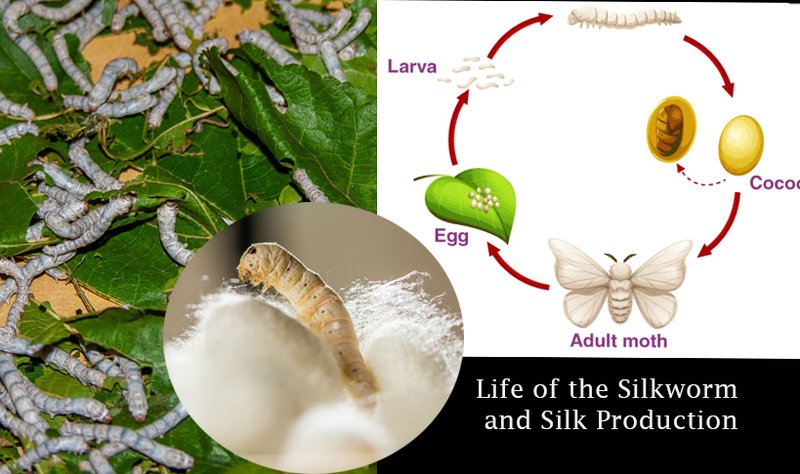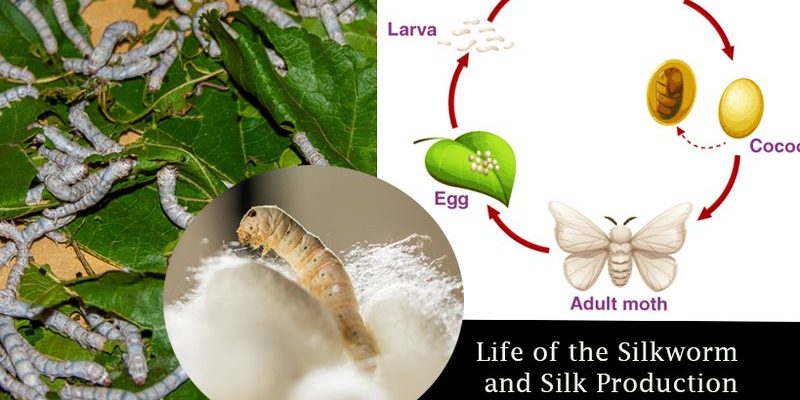
Silk is one of the oldest and most prized textiles in history, and it all starts with these unassuming caterpillars. You might think of them as just bugs munching on leaves, but they’re responsible for a fabric that has influenced culture, economy, and fashion since ancient times. In this article, we’ll dive deep into the world of silkworms—how they contribute to silk production, their historical significance, and the impact this beautiful fabric has had on the textile industry. So, grab your favorite drink, and let’s explore this incredible journey together!
What Are Silkworms?
Silkworms are the larvae of the domestic silk moth, scientifically known as *Bombyx mori*. These little creatures start their lives as tiny eggs, hatching into larvae that are utterly ravenous. Their primary diet consists of mulberry leaves, which they munch on voraciously. In fact, they can eat up to 20,000 times their body weight in just a few weeks! It’s like a teenager raiding the fridge, but instead of snacks, they’re preparing to make silk.
The transformation process of silkworms is truly incredible. After around 4 to 6 weeks of heavy feeding, they enter the pupal stage. During this phase, they spin a protective cocoon around themselves, using a single silk thread that can measure over a mile long. This cocoon becomes their chrysalis, where they eventually metamorphose into adult moths. But here’s the catch: harvesting silk requires humans to gather these cocoons before the moths emerge and break free. It’s a bit of a balancing act between nature and human necessity.
Silk production is a meticulous process, requiring patience and care. Each silkworm can produce about 1,000 to 3,000 feet of silk, which makes them incredibly valuable in the textile industry. The sheer level of work that goes into silk farming is staggering, but the result is worth it—soft, lustrous fabric that has adorned royals and commoners alike throughout history.
A Brief History of Silk Production
Silk’s history dates back over 5,000 years, with its origins believed to be in ancient China. Legend has it that the Empress Hsi Ling Shi discovered silk when a cocoon fell into her tea. Intrigued by the silky thread, she began experimenting, leading to the development of sericulture—the art of raising silkworms for silk production. Doesn’t that sound like a scene from a historical drama?
For centuries, silk was a closely guarded secret in China, valued for its beauty and rarity. The process of making silk was a well-kept trade, and anyone caught sharing this knowledge faced severe consequences. However, by around 200 BC, silk began to make its way along the Silk Road—a vast trade network connecting East and West. This exchange not only spread the popularity of silk but also facilitated cultural exchanges that shaped civilizations.
As silk traveled across continents, it became a symbol of luxury and status. From the grand palaces of Europe to the bustling markets of the Middle East, silk draped the rich and powerful. Furthermore, different regions began to develop their unique techniques and styles, incorporating silk into their traditional clothing and textiles.
The Process of Silk Production
So, how exactly is silk made? It all starts with the silkworms, but there’s much more to it than just letting them munch on leaves. The first step is to carefully breed the silkworms and ensure they have a steady supply of mulberry leaves. Farmers must monitor their health and growth closely, making sure they’re thriving.
Once the silkworms have spun their cocoons, it’s time for harvesting. Farmers typically do this by steaming or boiling the cocoons to kill the pupa inside, preventing them from becoming moths. This may sound harsh, but it’s necessary to extract the silk without damaging the fibers. After this, workers unravel the long silk threads from the cocoon, usually by hand, which can be quite the delicate job.
After the silk is spun, it undergoes several processes to enhance its quality and texture. The raw silk is washed, dyed, and woven into fabric. It’s during these stages that artisans can add their own flair, creating stunning patterns and vibrant colors that make silk garments so desirable. The entire process from cocoon to fabric takes time, but that’s where silk’s allure lies—its intricate journey gives it a uniqueness that synthetic fabrics simply can’t replicate.
Silk in Fashion and Culture
Silk has played a huge role in fashion and culture throughout history. In ancient China, it wasn’t just a fabric; it was a symbol of wealth and power. Only the elite wore silk, and it was often used in elaborate ceremonies, weddings, and festivals. It wasn’t long before silk began to spread beyond China, making waves in places like India, Persia, and eventually Europe.
In Europe, silk made its big debut during the Middle Ages, becoming a staple for the aristocracy. Imagine kings and queens adorned in flowing silk gowns and suits. This trend continued into the Renaissance, when silk became immensely popular among artists, leading to vibrant silk brocades that adorned everything from paintings to clothing.
Today, silk remains a fabric of choice for high-end fashion designers. Designers like Chanel, Valentino, and Gucci incorporate silk into their collections, showcasing its elegance in everything from evening gowns to ties. It’s not just about luxury; silk also brings a certain drape and feel that other fabrics can’t match. Honestly, slipping into a silk outfit feels like wrapping yourself in a cloud—a wonderful feeling!
The Environmental Impact of Silk Production
As beautiful and luxurious as silk is, we can’t ignore the environmental implications of its production. Traditional silk farming can be resource-intensive. Raising silkworms requires a significant amount of water and land, especially when compared to other fabrics like cotton or synthetic fibers. There’s also the energy and resources spent in the processing stages.
With growing awareness of eco-friendly practices, some silk producers are turning to more sustainable methods. Organic silk farming, for example, minimizes harmful chemicals and promotes healthier ecosystems. Farmers are now focusing on using natural fertilizers, planting a variety of crops, and ensuring safe habitats for wildlife. It’s a step towards making silk production more sustainable while still embracing its rich history.
Additionally, there’s a rise in demand for cruelty-free silk, which involves harvesting silk without killing the silkworms. Brands that prioritize ethical practices are gaining popularity among consumers who want to enjoy luxury while making conscientious choices. It’s great to see that silk can evolve and adapt to the times without losing its charm!
The Future of Silk in Textiles
Silk continues to hold its place in the textile world, but what does the future look like? With rapid advancements in technology, we’re seeing innovations in silk production that blend tradition with modernity. For instance, researchers are experimenting with lab-grown silk that offers the same luxurious feel without relying on traditional farming methods. This could potentially reduce environmental impacts while maintaining the quality silk lovers cherish.
Moreover, silk is making its way into different areas beyond fashion. Think about silk-based products in the beauty industry, like silk pillowcases and face masks, which are touted for their benefits to skin and hair. The versatility of silk is being recognized, and it’s likely that we’ll see more creative applications in the coming years.
As consumers become more conscious about the origins and impacts of the products they use, there’s an opportunity for silk to shine, especially when paired with sustainable practices. The blend of heritage and innovation makes silk’s future bright, and who knows? We might just find ourselves celebrating silkworms more than ever!
Silkworms have played a monumental role in weaving the fabric of history, culture, and fashion. From their humble beginnings in mulberry groves to the opulent garments that grace runways today, these tiny creatures have impacted textiles in ways we might not fully appreciate. As we move forward, it’s heartening to see the shift towards sustainable and ethical practices in silk production, ensuring that the allure of silk can continue for generations to come.
So, the next time you slip into something silky, take a moment to think about the little bugs that made it possible. Their journey isn’t just about producing a beautiful fabric; it’s a story interwoven with tradition, innovation, and a touch of nature’s magic. It reminds us that even the smallest of creatures can have a lasting impact on our world.

